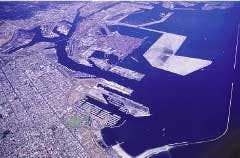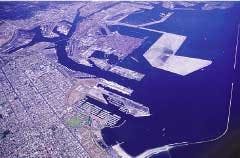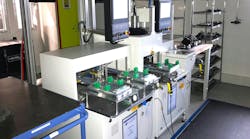WOODLAND HILLS, Calif. - Engineers at Northrop Grumman’s Navigation and Space Sensors division in Woodland Hills, Calif., plan to enhance maritime security in major ports across the nation with their new harbor defense system to identify and track potential underwater and surface ship threats.
Early detection and identification of threats to the harbor permits timely response by the reaction team receiving the information. U.S. Navy officials were among the special guests gathered at Naval Base Ventura County at Port Hueneme, Calif., to witness a demonstration by Northrop Grumman of the capability to provide an integrated view of a harbor based on information gathered from a variety of proven military and commercial sensors and systems, including underwater fiber-optic sonar sensors, marine radar, and a shipboard identification system.
Centurion, the integrated sensor and display product, showed the harbor vicinity and potential threats on a standard Navy display system located at the test site. During the demonstration, divers with a battery-powered underwater propulsion device were easily detected as they attemped to penetrate the harbor. Surface craft traveling in the test area, and entering the restricted Port Hueneme, were also detected and tracked.
“Integration of the radar, shipboard identification system, and the fiber-optic arrays exceeded the objectives for this phase of the program,” says Mary Ann Benischek, vice president of Situational Awareness Systems at Northrop Grumman’s Navigation and Space Sensors division. “Future program objectives include integration of additional sensors and further system optimization.”
The proof-of-concept demonstration was completed within three months of the contract award by the Navy’s Maritime Surveillance Systems Program Office, utilizing passive fiber-optic sonar arrays and support equipment delivered by Northrop Grumman’s Navigation and Space Sensors division, coupled with commercial off-the-shelf equipment provided by Northrop Grumman’s Sperry Marine business unit in Charlottesville, Va., company officials say.
The equipment provided by Sperry Marine included the marine radar, shipboard identification system, and the digital electronic charting system that provided the integrated harbor picture.
The Northrop Grumman team completed a threat analysis for the port and determined the most effective locations to place the underwater array. The array installation was performed with the assistance of the Naval Facilities Engineering Support Center and the team’s ocean engineering subcontractor, Sound and Sea Technology Inc. of Edmonds, Wash., and Ventura, Calif.
The next step in maturation of the technology involves optimizing the fiber-optic sonar arrays for the harbor environment, integrating additional sensors into the system, and demonstrating the enhanced integrated harbor picture that results from these improvements, Northrop Grumman officials say.
“The fiber-optic acoustic arrays used for Centurion represent a revolutionary new technology developed by our Navigation and Space Sensors Division,” says Alexis Livanos, vice president and general manager of the division. “The arrays provide a rugged, low-cost, and easy-to-install port monitoring solution when combined with the other Centurion system components.”
Performance benefits of this technology include unsurpassed detection, identification, and tracking capability for the harbor defense applications. Because no electronic components are in the water, the fiber-optic arrays provide a highly reliable solution that also offers reduced acquisition and maintenance costs.
“The fiber-optic hydrophone array technology employed is unique to Northrop Grumman and derives from 15 years of leadership in this field,” Livanos adds. “The arrays employ glass fibers, instead of older-technology piezoelectric hydrophones, to convert sound to modulated light for efficient transmission to shore. The sensor arrays have low power requirements and provide wide frequency coverage.”
The Navigation and Space Sensors Division and Sperry Marine are part of the Northrop Grumman’s Baltimore, Md.-based Electronic Systems sector.



